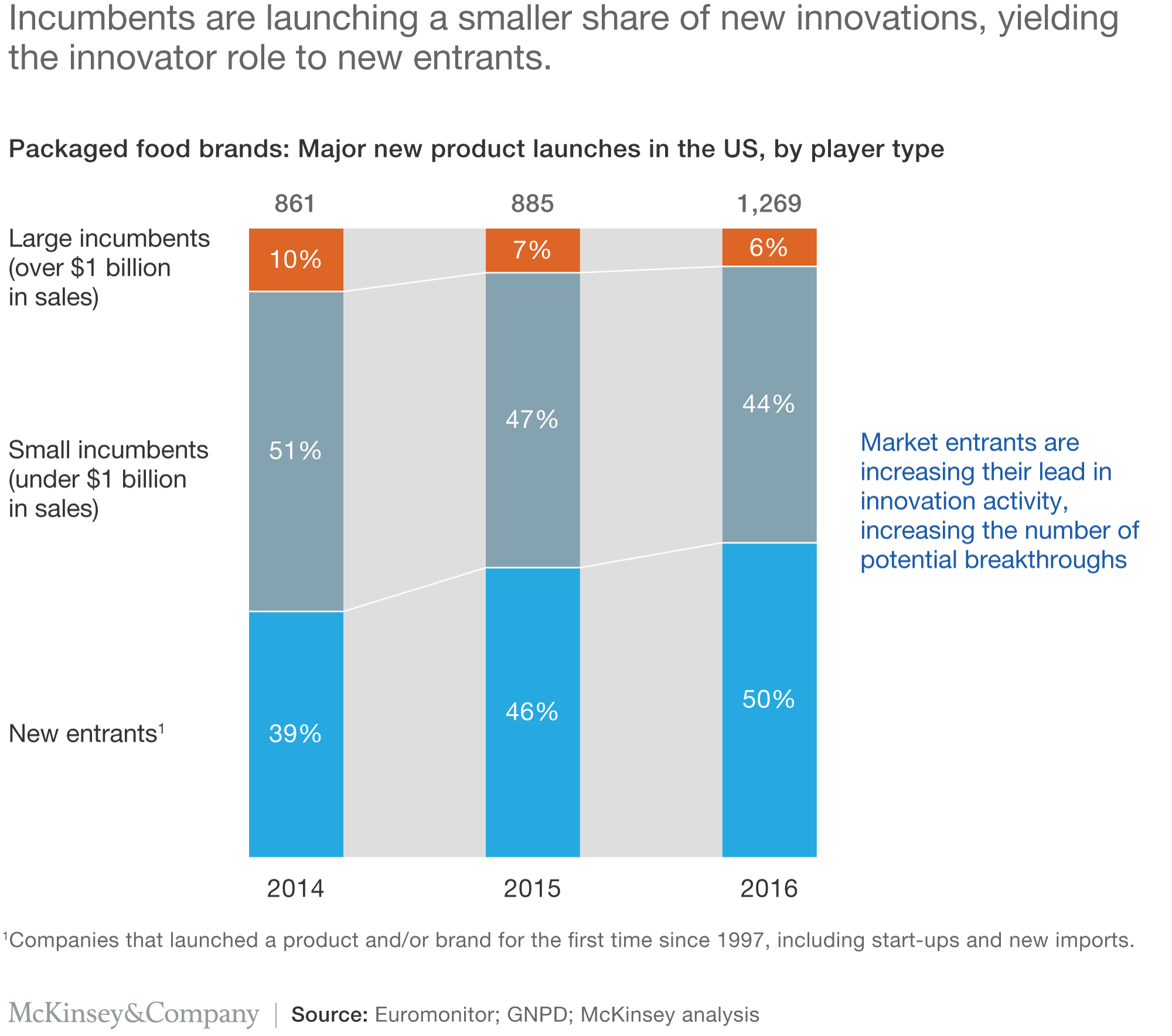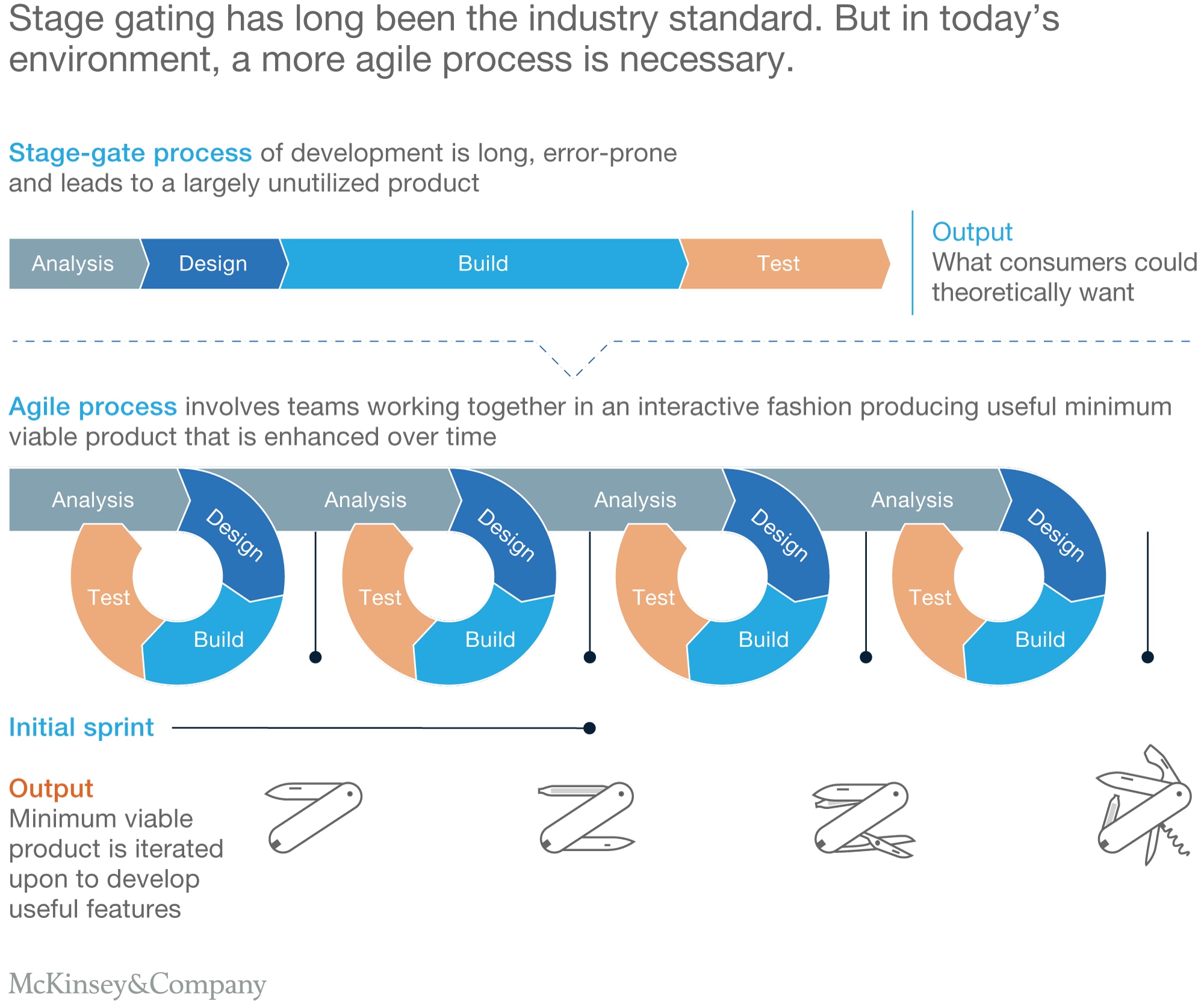Innovation drives growth in consumer packaged goods, but yesterday's product development practices just aren't delivering. It's time to try a new recipe.
Innovation drives growth in consumer packaged goods, but yesterday's product development practices just aren't delivering. It's time to try a new recipe.
Consumer-goods companies face a challenging growth environment. Adjusted for inflation, leading consumer-packaged-goods players are achieving an average annual growth rate of just 1.2 percent. Many factors are at work, but our proprietary research indicates that innovation is one of the most important ways that faster-growing players differentiate themselves from the rest.
It's also an area where big players are struggling. McKinsey analysis of market data indicates that large incumbents represent only 6 to 10 percent of packaged food launches in the US in a typical year (Exhibit 1). Separate Nielsen analysis shows that between 2012 and 2015, the top 25 US food & beverage manufacturers accounted for 45 percent of category sales but only 3 percent of category growth.

Why are these big companies losing the race? In many cases, we believe their approach to R&D is letting them down. Few consumer-goods players manage to configure their business processes to support real innovation and accelerate product development.
Why the original went stale
Winning in consumer-product innovation requires companies to do two things well. The initial challenge is to find, develop, and scale the right ideas. Those ideas must include both incremental innovations that keep established product lines ahead of the competition, and bolder innovations that open up new areas of the market or even enable entirely new business models. Next, they need to work fast, getting many more products out of the development lab and into the market before competitors can, or customer preferences move on.
Our research has identified four deeply-ingrained legacy R&D practices that can prevent companies from achieving these aims.
First, as companies attempt to standardize their R&D activities, they can end up following rigid, strictly linear innovation and product-development processes. Such standardization is good practice in many operational settings, but truly innovative product development can rarely be mapped out in advance.
Second, many consumer companies are still organized in silo-heavy matrices, with incentive systems and reporting lines that discourage effective cross-functional collaboration. For example, it is still common for marketing organizations to develop a perspective on product requirements and hand these to R&D for separate development. In a world where most of the easy innovations have already been developed, independent functional work rarely leads to groundbreaking ideas.
Third, many companies enforce rigorous stage-gate mechanisms that seek to avoid failure by requiring completion of a prescribed set of deliverables in a predetermined sequence. With low tolerance for deviation from these mechanisms, and expectations of a high return on investment and year-one margin expansion, perfect often becomes the enemy of good. These gates can screen out promising but risky ideas, and they tend to slow the whole development process down. That means successful ideas launch later and have less time to pay back before the market moves on
Fourth, even if formal review processes don't squash innovative ideas, executive mind-sets can make life hard for them. Business leaders often expect to see very mature concepts, even early in development. As a result, teams may only be willing to bring the most-completely baked ideas forward for evaluation, with riskier ones never seeing the light of day. Evidence for this this risk-averse mentality can be seen in the extremely high pass rates in many organizations' stage-gate processes: over 90 percent at one personal-care company. Working this way doesn't just undermine the value of the review process, it also stops companies adopting the "minimum viable product" mentality that has helped many start-ups to move fast and learn on the go.
Three fresh ingredients
To overcome these challenges, leading consumer-goods companies are taking a fresh look at their product-development models. The best of them have built an entirely new approach, drawing heavily on three big ideas that together can reduce time to market by as much as 75 percent. Working so much faster matters: shorter time to market lets companies rapidly test breakthrough ideas, and speed the refinement of incremental ones.
Agile thinking
To break down organizational siloes and accelerate the pace of innovation, leaders are borrowing ideas pioneered in the fast-moving world of software development. Using Agile Development principles, they empower small, dedicated teams to drive a specific product to market. Working this way ensures everyone's objectives are aligned, and eliminates the inefficiencies created when staff are forced to juggle multiple projects simultaneously.
Instead of rigorous stage gates, defined months in advance, agile teams work in one- to four-week sprints, focused on answering a specific set of questions in order to narrow the range of options under consideration. Almost every sprint delivers a new prototype product. These prototypes are then tested with the "market": either consumers, customers (such as retailers), or, early in the process, informed stakeholders who can stand in for these audiences. Teams work iteratively, continuously refining the prototype until they reach the point of market viability (Exhibit 2).

Two realizations are also leading many companies to identify external partners to complete key pieces of work. First, many tasks in product development have very uneven workloads over time: testing often involves periodic peaks in activity. Resourcing these "spiky" responsibilities externally enables a more efficient structure that minimizes bottlenecks, and often reduces overall costs.
Second, to break free from conventional wisdom and inject new thinking into their development processes, leading companies are also making greater use of external resources in the creative design process itself. Sometimes these are suppliers or contract manufacturers, but just as often they are independent research, design, and engineering firms that bring unique skills to bear, or provide a way to augment resources without increasing headcount. In some CPG companies, as many as 80 percent of the staff involved in product development activities are third-party employees.
Reinventing processes
Finally, in pursuit of ultimate speed and agility, companies are radically rethinking the way they carry out the most time-consuming product development steps. Rather than starting from their current way of working and looking for incremental improvement opportunities, these companies are adopting a "zero-base" approach, asking just what they can achieve with the best possible processes and technologies. As an example, techniques such as 3D printing and Finite Element Analysis can significantly reduce the need for quality testing of packaging and other physical elements. At one consumer goods company, such an exercise reduced expected verification time by approximately 60 percent. Consumer testing is another area seeing a similar reinvention, with companies replacing large-scale testing with a more iterative approach using lower sample sizes at each step.
***
At many companies, these changes require fundamental reinvention, not just of the product development process, but also of the broader organizational and operating model. Leaders are proving themselves up to the task. One food and beverage company was able to use a combination of the approaches described above to achieve a fourfold increase in the rate at which it launched major new innovations, while decreasing its average spend per project by 70 percent.
Consumer goods companies face many challenges and an imperative to restore growth. To accomplish this, a reformulation of the innovation process is one of the best investments they can make.
About the author(s)
Shaun Callaghan is a partner in the New Jersey office, Jan Henrich is a senior partner in the Chicago office, and Brian O'Neill is a partner in the Atlanta office.